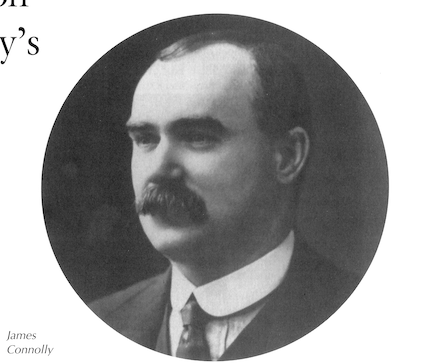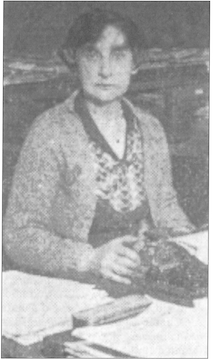James Connolly’s relationship with Catholicism has been much debated. During his lifetime he argued extensively (against both Catholic and socialist opponents) that there was not necessarily a conflict between Catholicism and socialism. While Connolly demolished the cruder assertions of his adversaries, commentators then and since have pointed out that he evaded some obvious difficulties, such as the problem of distinguishing between the public world of applied socialism and the private sphere to which he assigned religious belief.

It is clear that some of his professions of religious belief were undertaken for political reasons. His wife Lily (née Reynolds) was a Protestant, though they married in a Catholic church and their children were brought up as Catholics. In 1906 Connolly wrote to a friend (perhaps with a touch of bravado) that he ‘had not a tincture of faith left’ and had not been to his duty (i.e. Confession and Communion) for fifteen years, though he respected sincere Catholics.
Last rites
Nevertheless Connolly received the sacraments of the Catholic church while in prison after the 1916 Rising (to the relief of Pearse, who had feared that he might refuse them). His motives have been subject to much speculation. Some anti-socialist writers, such as Brian O’Higgins and Fr. Denis Fahey, claimed his action amounted to a repudiation of socialism, while most recent writers incline towards the view that Connolly only accepted the last rites in order to avoid damage to the labour movement.

Annie Smithson
None of Connolly’s biographers seem to have used the autobiography of the nurse and novelist A.M.P. Smithson (1873-1948). While working as a child welfare nurse in Dublin slums during the 1920s, she befriended Lily Connolly, who often spoke of her life with James and the hardships they endured.
Smithson claims that Lily Connolly described her last visit to James on the night before his execution, and said that after telling her he would be shot at dawn he asked her, as his solemn last request, to undertake instruction in the Catholic faith and then be received into the Catholic church if she felt she could do so. He added that he had not always been an exemplary Catholic, but he very much wanted her to do this. Lily duly underwent instruction and became a devout Catholic.
A glimpse of Lily Connolly’s religious activities occurs in Fr. Robert Bradshaw’s Frank Duff: Founder of the Legion of Mary (New York 1985). Bradshaw describes how she co-operated with Duff to retrieve some children from a Protestant proselytising agency and mentions that she later went on the Lough Derg pilgrimage with Duff.
Daughter’s version
How reliable is Smithson’s account? There is no direct conflict with the account of the last visit given by Nora Connolly O’Brien, as Connolly O’Brien makes it clear she is not recording all her father said to her mother. Smithson was writing more than a decade after the period in which she places her acquaintance with Lily, and her account implies that Lily was no longer alive when the book was published (though the Connolly children and family acquaintances were available). On the other hand, Smithson says that she had a prolonged acquaintance with Lily, and as Smithson was herself a convert from Protestantism to Catholicism she might be expected to take particular interest in another convert’s story.
Lucid autobiography
Despite Smithson’s activities as a sentimental novelist, the autobiography is lucid and does not avoid mentioning several painful experiences. It does not show any obvious tendency to fantasise (although there are a couple of stories about encountering ghosts in hospitals where she worked as a student nurse), nor does it show any signs of the sort of anti-socialist bias which might lead her to fabricate such a story. Smithson was a Fianna Fáil supporter, not necessarily incompatible with a social conscience; she comments on the contrast between the poverty she saw during her work in the Dublin slums and the habitués of the smart shops and restaurants a short distance away.
This piece of evidence is clearly of interest, since it suggests Connolly’s reception of the last rites was sincere (unless it is suggested he might have been prepared to deceive his wife, even under such circumstances, for the greater good of the labour movement) though it has little bearing on his earlier attitudes and cannot be taken as a wholesale recantation, as was claimed by Fahey and O’Higgins. It indicates, however, the sort of significant historical details which can be found in unexpected places, the tendency of Connolly biographers to ignore Lily’s life after her husband’s death, and the lack of scholarly attention given to
Smithson whose novels are interesting for their popularity, whatever their literary shortcomings.
Patrick Maume is a junior research fellow at the Institute of Irish Studies, Belfast.
Further reading:
Levenson, James Connolly (London 1973).
McKenna, The social teachings of James Connolly (Dublin 1920, 1991
A.N.P. Smithson, Myself and Others: an autobiography (Dublin 1944).
N. Connolly O’Brien, Portrait of a rebel father (Dublin 1935).
